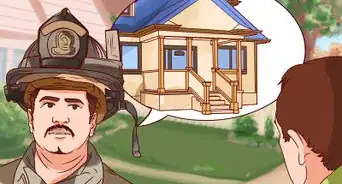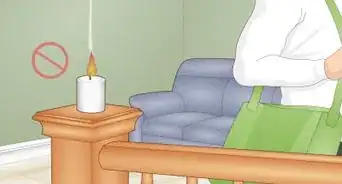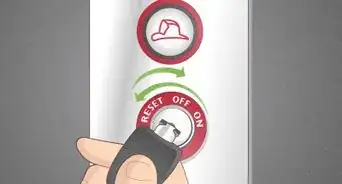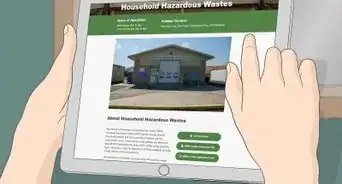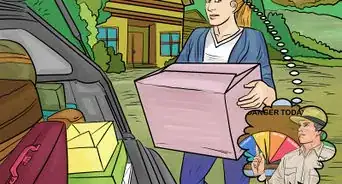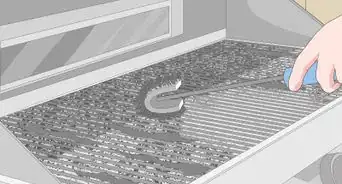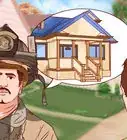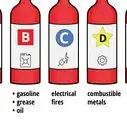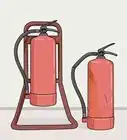This article was co-authored by wikiHow Staff. Our trained team of editors and researchers validate articles for accuracy and comprehensiveness. wikiHow's Content Management Team carefully monitors the work from our editorial staff to ensure that each article is backed by trusted research and meets our high quality standards.
This article has been viewed 121,049 times.
Learn more...
If you hear the fire alarm go off and you're at school, listen up. Your teacher and the other adults at your school are trained in fire safety. They will guide you and your classmates out of the building. When you hear the alarm go off, get quiet so you can hear your teacher. Follow all of their instructions. Remember to walk, not run, as you exit the building.
Steps
Evacuating the Building
-
1Listen to your teacher. When the fire alarm goes off, get quiet and listen up. Your teacher will remind you of what to do. Don't interrupt your teacher or talk to students next to you. There may also be an announcement on the loudspeaker, so listen up for that as well.
-
2Exit the building on your own if you are not with your class. The fire alarm might go off when you're in the bathroom or hallway. If the fire alarm goes off and you're not in your classroom, walk out of the building and go to the assembly point. Ask the nearest teacher or staff member what to do next.[1]
- If you see a class exiting, join them. Tell the teacher you are from another class.
- If a teacher or staff member at your school gives you directions while you're on your way to the assembly point, follow them.
Advertisement -
3Line up at the door. Your teacher will direct you to line up at the door. Line up in a single file line. Stay in your line.[2]
- If you are someone's helper, line up with them.
-
4Leave your things. When there's a fire alarm, it's important to react immediately! Don't worry about the project you are working on or the game you are playing. Put your things down.[3]
- Your safety is more important than your things. Any stuff you bring with you will slow you down.
-
5Walk outside quietly. Stay in your line as you leave the building. Follow your teacher to the nearest exit. While in line, stay quiet and keep your hands to yourself. Avoid pushing your classmates or any other students.[4]
- Walk normally, and never run.
- Stay in line so your teacher can keep track of you.
-
6Stay at the assembly point. Once your class has walked to the assembly point, your teacher will probably call roll. Listen for your name and respond when you are called.[5]
- If the building is on fire and there is a danger of explosion, face away from the building.
- Do not re-enter the building unless your teacher directs you to.
Being Safe around a Fire
-
1Stop, drop, and roll. If your clothes catch on fire, put the fire out by stopping where you are, dropping on the ground, and rolling. Rolling will smother the flames against the ground.[6]
- Keep rolling until the flames are gone.
-
2Get low to avoid smoke. Breathing smoke can hurt you and make you pass out. Smoke rises, so you can avoid it if you get under it. If you see smoke, crawl to stay below it.[7]
-
3Breathe through a cloth. If it is smokey, put cloth over your mouth and breathe through that. Pull your shirt up over your mouth, for instance. Put a little water on the cloth first if you can.[8]
-
4Yell for help. If you're alone and there's a fire, yell for help. If you are in your room and there's a fire in your house, open your window and yell for help. Yell until you have attracted someone's attention.
- Never hide when there's a fire. The firefighters need to be able to find you.
-
5Alert others if you see fire. If you are at school and you see a fire, get away from the fire immediately. Run and tell an adult about the fire. Even if you or someone else started the fire, don't worry about getting in trouble. It's more important that nobody gets hurt.[9]
- Pull the alarm.
- Use your phone to call an emergency number once you are out of the building.
- Call 911 if you are in the US, Canada, Mexico, or another country that uses 911 as an emergency number.
- If you are in Europe, call 112.[10]
Community Q&A
-
QuestionWill I get in trouble for talking or whispering during the fire drill?
 Gamer_GalaxiesCommunity AnswerYou mainly get in trouble for talking or whispering during a lockdown. It may be best not to talk or whisper during the drill because a teacher may be giving directions.
Gamer_GalaxiesCommunity AnswerYou mainly get in trouble for talking or whispering during a lockdown. It may be best not to talk or whisper during the drill because a teacher may be giving directions. -
QuestionWhat if I get in trouble?
 Community AnswerYou should only pull the fire alarm if you are in danger. You will get in trouble if you pull it for no reason, as that is dangerous and against school policies.
Community AnswerYou should only pull the fire alarm if you are in danger. You will get in trouble if you pull it for no reason, as that is dangerous and against school policies. -
QuestionHow far away from the school building do students and staff have to be during a fire?
 Community AnswerStudents and staff should get as far away from the building as possible while still practicing basic safety (like staying out of roadways). Each school should have its own evacuation plan in place, including a meeting point for students and staff that have exited the building.
Community AnswerStudents and staff should get as far away from the building as possible while still practicing basic safety (like staying out of roadways). Each school should have its own evacuation plan in place, including a meeting point for students and staff that have exited the building.
References
- ↑ http://www.hxedison.org/documents/HuaxiaEdisonEmergencyExitPlan-EdisonHigh.pdf
- ↑ https://www.oxfordshire.gov.uk/cms/content/fire-drill-routine-schools
- ↑ http://kidshealth.org/en/kids/fire-safety.html#
- ↑ https://www.oxfordshire.gov.uk/cms/content/fire-drill-routine-schools
- ↑ https://www.oxfordshire.gov.uk/cms/content/fire-drill-routine-schools
- ↑ http://kidshealth.org/en/kids/fire-safety.html#
- ↑ http://kidshealth.org/en/kids/fire-safety.html#
- ↑ http://kidshealth.org/en/kids/fire-safety.html#
- ↑ http://kidshealth.org/en/kids/fire-safety.html
About This Article
Hearing a fire alarm at school for the first time can be scary, but if you listen to your teacher’s instructions you’ll be able to quickly and safely leave the building. When the alarm first goes off, quiet down and listen to your teacher’s directions. There might also be a loudspeaker announcement with directions on what to do. Most likely, you’ll need to line up single-file at the door to your classroom, then quickly and quietly follow the leader outside. Don’t worry about bringing any of your belongings with you, since they’ll just slow you down. To learn how to safely stop, drop, and roll, read on!
-Step-1-Version-2.webp)
-Step-2-Version-2.webp)
-Step-3-Version-2.webp)
-Step-4-Version-2.webp)
-Step-5-Version-2.webp)
-Step-6-Version-2.webp)
-Step-7-Version-2.webp)
-Step-8-Version-2.webp)
-Step-9-Version-2.webp)
-Step-10-Version-2.webp)
-Step-11-Version-2.webp)
